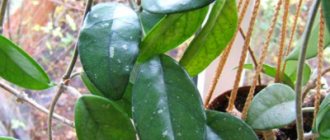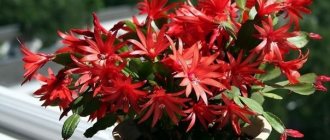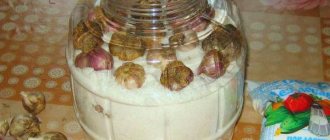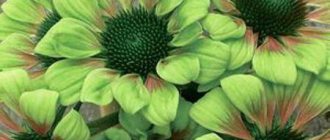Beautiful and productive beds with your own hands
Home › Houseplants › Homeland of the plant “Decembrist”
My Decembrist, after several years of a healthy, fulfilling life, began to dry out and fade. To understand what was happening to it, I became interested in the origin of this popular plant.
Having understood this issue, I better understood what conditions the plant requires and why. If the logic is clear, then it is easier to remember the information rather than re-learning an article about caring for a flower every time.
After I thoroughly understood the living conditions of the Decembrist in natural conditions, it became easier for me to create them in my apartment. Now my Decembrist blooms every winter, attracts attention, and looks great! I see that he has enough lighting, nutrients, and moisture.
In this article I will share with you information about how Decembrist grows in the wild. This is really very interesting! In addition, this information will help you get to know your Decembrist better and, perhaps, even fall in love with this unusual indoor plant.
Brief description of the flower
It is difficult to imagine that under natural conditions, the Decembrist plant, which is familiar to many, grows in the tropics on the trunks and roots of trees. It belongs to the family of forest cacti and is a zygocactus. The botanical name of the flower is Schlumbergera. It was named after the Frenchman Frederic Schlumberger, who had an extensive collection of succulents.
In nature, the plant lives on trees
The plant is a shrub formed by hanging, branched, flattened stems. The stems are formed by oblong segments with small denticles along the edges.
Advantages and disadvantages
Decembrist is a perennial that does not require special growing conditions. Even inexperienced gardeners can grow such a flower. Thanks to its hanging stems, it is often used as an hanging plant.
Decembrist - ampelous plant
The plant has shallow roots, which makes it demanding on soil quality. However, even in unfavorable conditions, the flower is able to survive due to the presence of aerial roots that receive moisture from the air.
Aerial roots allow the flower to receive moisture not only from the soil
How and when does the Decembrist bloom?
To see how the Decembrist blooms, you need to wait until winter. It is thanks to this fact that it received its popular names - Decembrist, Christmas cactus or Rozhdestvennik.
Flowering occurs in winter
The natural color of the inflorescences ranges from white and crimson. Through the efforts of breeders, hybrid species with inflorescences of pink, salmon, yellow and other shades appeared. Schlumbergera flowers are lush, multi-tiered, and have a bunch of elongated stamens.
Interesting facts about zygocactus
Beginning flower growers should know interesting facts about the Decembrist:
- This is a long-lived flower that can last 20–25 years.
- This type of cactus thrives in cool temperatures.
- Loves frequent spraying, but watering too often will kill it.
- It is advisable to let the zygocactus “sleep” at night without light.
Decembrist (Zigocactus Schlumberg) is classified as a forest cactus, although it does not have spines. This is an unpretentious flower that even beginners can grow. The main thing is to follow the recommendations given by experienced flower growers.
The original article is here: https://world-of-colors.ru/vidy/cvetok-dekabrist/
Varieties of the Decembrist flower: photos, features
Schlumbergera truncated is a very common species. Its stems have reddish veins and its flowers range in shades from pale pink to purple.
The stems of Schlumbergera truncata reach 40 cm
Schlumbergera Bukleya is an ampelous species, has drooping dark green shoots.
In recent years, the collection of hybrid varieties has been significantly expanded. Schlumbergera Lavender Doll is perfect for hanging. The inflorescences have a lavender hue. Depending on the subspecies of Schlumbergera, Lavender Doll has different flower shapes and lengths. Schlumberger's Christmas Fantasy is very popular among gardeners. Plants of this species have a rare delicate salmon shade. The inflorescence of the Sanibel variety is the same color.
Schlumbergera Pasadena has showy bright flowers
Among the hybrids with yellow flowers, the popular varieties are Gold Charm, Christmas Flame, Cambridge, Christmas Cher, and Twilight Tangerine.
The Cambridge variety was developed by crossing the Gold Charm and Christmas Flame varieties.
White Christmas is the most common variety with white flowers. One of the distinctive features of this hybrid is its long flowering period. Schlumbergera Opuntioides attracts attention due to the unusual appearance of its stems. The branches of this variety are covered with thorns.
The bright yellow flowers of the Golden Fever hybrid resemble an orchid
Hybrid Madame Butterfly blooms earlier than other species
How to care for the Decembrist flower at home
Schlumbergera is an unusual type of cactus. It blooms in winter and does not like high temperatures and bright sunlight. Therefore, the conditions for its maintenance are radically different from the conditions for growing other cacti and succulents. There are certain rules on how to care for Decembrist so that it blooms and has lush and healthy stems.
Lush flowering depends on maintenance conditions
Temperature conditions of growth, location determination
Decembrist, like other representatives of zygocacti, cannot tolerate exposure to direct sunlight. However, the plant requires good lighting. Therefore, for the location of the Decembrist, it is preferable to use window sills on the eastern side of the room. In summer, the flower can be placed in the open air or on the balcony.
HELPFUL ADVICE!
During the period of bud formation, the plant cannot be moved. This may cause the buds to drop.
Temperature conditions should be selected depending on the periods of plant development. Active growth (vegetation) occurs during the warmer season - from April to September. During the growing season, the flower needs free access to oxygen; the ideal temperature for it will be +20°C.
In the fall, Schlumbergera freezes to prepare for flowering. Incorrect maintenance is the reason why Decembrist does not bloom at home. For a comfortable rest, the flower needs to create conditions of coolness and low humidity. If the plant was kept in the air in the summer, then in the fall it can be left there, keeping the temperature at least +12°C, the temperature in winter - from +16°C to +22°C.
What kind of land is needed for the Decembrist
Before planting Decembrist, you should prepare high-quality soil for it. Schlumbergera is a representative of a species of epiphytes that naturally grow on other plants. Accordingly, the soil must freely allow moisture and air to pass through. The soil mixture consists of leaf soil and sand in equal parts. For better nutrition of the flower, peat or charcoal is added to the mixture. Packaged soil for cacti, sold in stores, is not suitable, as it contains an excessive amount of peat.
The soil for cacti is oversaturated with peat
Rules for transplanting Decembrist at home
How to replant Decembrist at home so as not to harm the flower? It is recommended to do this after flowering in early spring. For the first few years, shoots are replanted every spring, then once every 3 years. The new pot should be 2 cm larger in diameter than the old one. One third of it is filled with drainage. To improve moisture permeability, fine expanded clay is added to the soil mixture. Schlumbergera does not require a high pot as it has shallow roots.
How to water Decembrist depending on the time of year
Unlike other cacti that can be watered infrequently, Schlumbergera requires regular watering. However, you cannot flood the flower, as its roots may rot. You need to water with soft water at room temperature.
The plant requires the most moisture during flowering. In autumn, Decembrist is watered as the soil dries out.
Spraying allows you to get rid of dust on the stems.
During the growing season, moderate watering is needed. Decembrist must be regularly sprayed with warm water so that the plant receives moisture and the stems are cleaned of dust.
Catalog of indoor flowers with photos and their names. In a special publication on our portal we will talk in detail about indoor flowers. You will learn the types of indoor flowers, about fruit indoor flowers and get acquainted with the photo gallery.
Transfer
The main point when replanting is to select the right soil for growing.
It is very important that the soil is nutritious. Peat soil is often used for this purpose.
You can purchase it ready-made at a specialty store or prepare it yourself.
It is imperative to place a good layer of drainage at the bottom of the container, the benefit of which is to protect against premature rotting of the root system and stagnation of moisture. This way we will not harm the plant. A good drainage layer should occupy one third of the entire container.
The container must be chosen wide enough and not very deep, due to the fragile structure of the root system. Transplantation should be carried out after the completion of flowering at the onset of the dormant period, namely at the beginning of the spring season. Young specimens of indoor Decembrist must be transplanted annually, adults - once every 3 or even 4 annual cycles.
How to propagate Decembrist at home
Schlumbergera is propagated by cuttings. Several outer segments of the shoot are unscrewed and left to dry for several days. To obtain new healthy plants, it is important to know how to properly plant a Decembrist shoot. Dried links are planted in pre-moistened soil and covered with a jar or film to create a greenhouse effect. The shoots take root in a shady place at temperatures from + 16°C to + 20°C.
Sprouts take root best in the shade
It is convenient to propagate the flower after pruning it during the formation of the bush.
IT IS IMPORTANT TO KNOW!
The formation of a bush is done by unscrewing unnecessary and diseased links before the buds appear. At this time, many healthy segments appear for reproduction.
Reproduction
Information alone on how to care for the Decembrist will not be enough. You need to know how to properly reproduce this indoor pet. First of all, you need to thoroughly study its description and only then begin to reproduce it.
The process is carried out by cuttings. To carry it out, you need to select no more than three outer segments and carefully separate them from the parent plant.
The use of metal or sharp objects is strictly prohibited. All manipulations are carried out by hand.
Thanks to the work done, you will not only be able to get the coveted cutting, but will also significantly improve the health of your home plant.
For two to three days, you need to dry the cuttings well, then deepen them into moist soil and cover them with a jar or film. Do not forget about regular ventilation and maintaining a temperature regime of 15 to 20 degrees above zero.
How to make Decembrist bloom at home: care rules and folk remedies
With proper care, Schlumbergera blooms regularly in winter. Stimulates flowering by pruning diseased stems, since buds form only on healthy shoots, and by feeding the plant. Bud formation is promoted by potassium and phosphorus fertilizers, wood ash, as well as universal fertilizers for cacti. In summer, nitrogen fertilizers are used. Feeding should be done every three weeks and stop a month before flowering.
30 days before flowering, fertilizing must be stopped.
Folk methods for caring for Schlumbergera include watering with tea leaves. This feeding is carried out in the autumn, when the plant is resting, as well as in winter during flowering. It is believed that the formation of buds is stimulated by the infusion of the shell. The washed eggshells are infused in warm water for 24 hours.
It is important to remember that changing the location of the plant may cause the flowers to drop. To extend the flowering period, wilted inflorescences should be removed in time. More details about the flowering of the Decembrist are described in the video:
Disease and pest control
Like any other indoor plant, Decembrist is susceptible to diseases. Prevention and timely treatment of diseases, as well as preventing the appearance of pests is the most important element of care. The plant can be attacked by several types of pests. Information about them is presented in more detail in the table.
| Pest | Manifestation | Fighting methods |
| Shields | Convex brown spots on stems. | Rinse the stems with a stream of warm running water, wipe with a damp cotton pad, grated with laundry soap, and treat the plant with an insecticide according to the instructions. |
| Spider mite | “Rusty” coating on the stems, thin cobwebs. | |
| Mealybug | Small white clumps resembling cotton wool between stem segments. |
Scale leaves brown spots on stems
Why does the Decembrist have limp leaves? Causes, disease prevention, treatment
What to do if the Decembrist stems wither? First of all, it is necessary to understand the reason for this behavior of the plant. Wilting can occur due to insufficient watering, hypothermia, overheating under the sun, or excess fertilizer in the soil. In all these cases, for Schlumbergera to recover, it is necessary to eliminate the factor causing harm.
If the fading of the shoots and loss of elasticity are added to the wilting of the plant, we can conclude that the flower is infected with a fungal disease. In this case, treatment with fungicides and replanting in new soil will help.
Droopy leaves may indicate a fungal disease or improper care.
Why do Decembrist leaves turn red, and how to fix it
The cause of reddening of the shoots can also be improper maintenance conditions. Due to bright light, improper feeding, and excessive watering, stem segments may turn red and fall off. It is recommended to replant the plant and create more comfortable conditions for growth. Often red leaves are a sign that the plant is frozen. In this case, it should be moved to a warmer place, then the stems will again acquire a healthy appearance.
Signs and superstitions associated with the Decembrist flower
Decembrist is a favorite of many housewives. However, superstitions associated with it can set flower growers against this beautiful flower. Perhaps the most terrible sign is the opinion that the Decembrist foretells death. It is believed that if a plant withers and dies for no apparent reason, then the death of one of the household members will soon occur in the house. Some people call the flower muzhegon. That is, the owner of this plant will remain an old maid or will constantly quarrel with her husband.
Some gardeners are afraid to plant a Decembrist plant because of superstitions
But Schlumbergera also has positive signs. For example, it helps owners identify an ill-wisher. If a flower becomes ill-tempered after visiting the house of a particular guest, it is believed that this person wishes harm to the owners. There is an opinion that Schlumbergera, blooming on time, predicts a successful year. But flowering in the warm season predicts failure.
A little about the history of its names
Decembrist belongs to the genus of epiphytic cacti. Their homeland is tropical forests at an altitude of 900 - 2800 m in the southeast of Brazil. There they still grow on tree branches.
The Decembrist was brought to Europe from Rio de Janeiro by collector Allan Cunningham in 1816. In 1858, the cactus was given the name Schlumberger. This is how it was named by the French botanist and writer, taxonomist of wildlife, Charles Antoine Lemaire (1800 - 1871) in honor of the French cacti collector Frederic Schlumberger (1823 - 1893). Before this, this cactus was called Epiphyllum.
In 1890, another name was added - Zygocactus. Zygocactus blooms from November to January, just at the height of summer in its homeland in the tropics. The peak of flowering occurs in December, so people call it simply: Dekabrina, Christmas cactus, Rozhdestvennik. In Japan it is called the Russian cactus. But the most popular name of this plant is Decembrist.











